
We leave Johannesburg a few days after Christmas to start our meandering circuit around South Africa. Our first destination is the province of Kwa Zulu Natal in the north east section of the country, Kwa Zulu meaning land of the Zulus and Natal the traditional British name for the area. KZN has some stunning boundaries; the Indian Ocean on its east side, Mozambique and Swaziland to the north, and the Drakensberg mountains rising up to Lesotho in the west. There are an abundance of national parks and reserves with attractions ranging from soaring peaks and plunging waterfalls to wetlands and coastal rain forests, and animals including giraffe, elephants, antelope, hippos and the big five in game reserves.
We’re headed for Durban to stay with Paul’s sister Sarah for a few days but we’re breaking the trip with an overnight stay at the base of the northern section of the Drakensberg mountains in the Royal Natal National Park. The drive out of Johannesburg is predictably busy and after passing through the centre of the city we find the freeways the easiest way to pass through the flat and fairly monotonous highveld to Harrismith. We leave the freeway here and the scenery becomes far more interesting.
The Drakensberg Mountains dominate the skyline to the right. They rise high above the surrounding plains and the closer we approach the more dominant they become. Along the way we pass Sterkfontein Dam, even this is high enough for vultures to be fed at a spot beside the dam but feeding isn’t in progress and we don’t see any vultures today. We turn toward the mountains and after driving along winding roads past villages and smiling people we enter the Royal Natal National Park. We have booked a campsite at the Rugged Glen camping area. It’s the smaller of the two camps in this section of the park and while it is slightly further from the mountains and has a less commanding view it is far quieter, especially at this time of the year, and it is surrounded by lots of tall trees so we are very happy with our choice. During our lunch the clouds over the mountains thicken and a short rain shower is accompanied by thunder and lightning. By the time we’ve finished eating the rain has almost stopped so we take a drive into the heart of the park. The grey clouds start to break up and the sun shines on wet rocks making them glisten and accentuating their colours. When we reach the end of the road the clouds are still around but they have lifted a little so we see the full expanse of the 5 kilometre long curved cliff face that is The Amphitheatre. The top of The Amphitheatre is around 2,000 feet above us.
A number of walks start from the car park at the end of the road and although we have no intention of completing any of them today we take a short walk up the track to see if we can get a clearer view of the mountains. The bushes around the track keep us cool but obscure the view and a fallen tree we would have to climb over or crawl under discourages our onward journey but it was nice to get out and stretch the legs for a change. We stop along the road and also at the dam on our way back and Paul is happy with the views he captures in his photos.
As we are only staying one night we use the roof top tent instead of setting up the camper trailer tent and we spend a cosy night listening to the wind in the trees. In the morning we make an early visit to the dam for more photos. It’s a glorious sunny morning so we are treated to a full view of The Amphitheatre with just a few wispy white clouds in an otherwise clear blue sky. It’s far more common for the cliffs to be obscured by clouds so we have been very lucky.
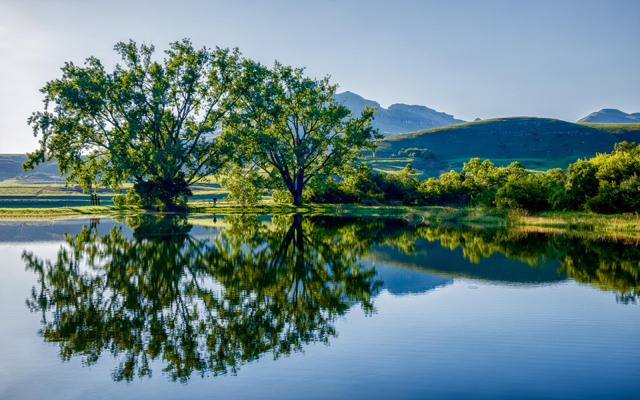
By the time we have returned to camp for breakfast and showers it’s mid morning and we have quite a lot of driving to do. We start by following dirt roads through the low hills past villages to the town of Bergville. We’re in the Midlands section of KZN now and while we could rejoin the freeway and have a quick drive into Durban we meander along secondary roads through pretty villages with names like Nottingham Road and Lions River, and past the Capture Site where Nelson Mandela was arrested. Gently rolling hills surround us now but as we are still fairly high above sea level the temperature is mild, a great place of retreat from the heat and humidity on the coast during summer or the cold winters in the Highveld. The ample guest houses, restaurants and craft shops, many with very kitsch names like Piggly Wiggly, Toad Hall Cottages and The Patchwood Elephant show the popularity of the area as a holiday destination.
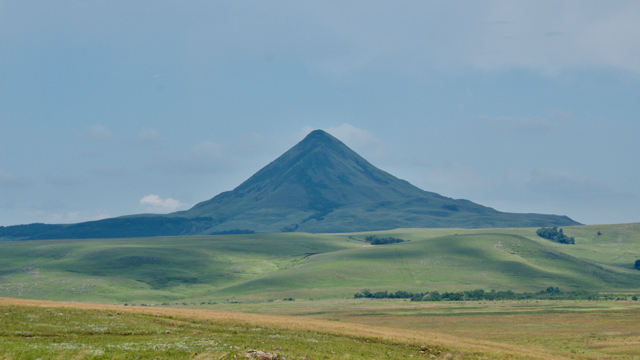
We make a stop for coffee in one town and lunch in another and then stop in Howick where we admire the view of the waterfall right near the town centre. It’s hot and busy with tourists so we don’t stop long and soon we’re entering the Valley of a Thousand Hills, the heart of Zululand. More magnificent scenery is on offer although there is a lot of heat haze. Dirt roads wind up and down the ranges in the distance, it would be great to have the time to explore deeper into the valley but for now we must follow the main road which skirts the edge. Soon the road descends and we rejoin the freeway for the final run into Durban.

We spend the next few days with Sarah and Ian at their home in the northern beach side suburb of La Lucia. We take a drive into the city centre and through some of the picturesque suburbs one day and return to the CBD the next day with Sarah’s son Dylan to visit the markets. A guide certainly helps here as there are multiple sections spread out over a few blocks with high walkways and stairways between the old market and the newer tourist market, the fish market and the meat market. Fruit and vegetables are in yet another section and the last one we visit is given over to traditional medicines with many strange barks and powders on offer. It’s the day after New Years Day and technically a public holiday so not all sections of the market are open, it sure would be chaotic in normal times. We leave with some spices to sample and hope to return if time permits.
We are conscious of time restraints but there is a large section of KZN north of Durban we would like to see while we are in the area so we leave the trailer at Sarah’s and head off with the roof top tent. Its raining today but the forecast for tomorrow is clear so we are hopeful of some good sight seeing. Our first destination is Hluhluwe-Imfolozi National Park. I have finally got my tongue around some of the place names here. Many have multiple consonants like the capital of Swaziland, Mbabane which is not too difficult being pronounced ‘m-ba-barn’, but Hl is tricky and is pronounced as a guttural ‘shl’, so Hluhluwe becomes ‘shlu-shlu-wee’, or at least something like that. There is a lodge and chalets in the national park but they are quite expensive and there is no camping nearby so we have decided to stay at a backpackers near the northern entrance to the park. It has very good reviews but we decide that while it is acceptable for a night’s stay the reviews are over-rated. Never mind, we take a drive in the park in the afternoon, return for dinner and to sleep and we leave before breakfast in the morning to enter the park soon after it opens at 5.00am.
The northern section of the park, Hluhluwe, has many grassy hills and we follow dirt tracks up and around the hills and down to a pleasant picnic area by the river. The rain has made the tracks very slippery, no problems for us but we watch one small car spinning its wheels as the driver tries to back out of a muddy section. Luckily he made it as we were not looking forward to getting out in the mud to help him. We enjoy the scenery and spot lion, rhinos, buffalo, wildebeest, zebra, wart hogs and various antelope but it isn’t until we head to the southern section of the park, Imfolozi, that we see giraffe and elephants. There are also reportedly lion, leopard, cheetah and wild dog in this section along with a wider range of antelope but we don’t see any of these in the time we have available.
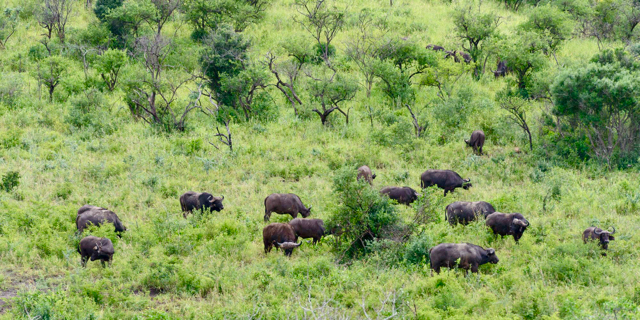
We had thought of having two nights here but as we weren’t impressed with the accomodation we decide to drive to another game park not too far away where they have both camping and very reasonably priced rest huts available. The iSimangaliso Wetland Park stretches along the north coast of KZN from the border of Mozambique 200 km south to St Lucia and inland to the uMkhuze Park. The park was listed as South Africa’s first World Heritage Site in 1999 and the name means miracle or wonder so it is not surprising that we we plan to visit as many of the sections of the park as we can. uMkhuze is our first destination in this system. As well as bushland sections of the park there are large pans spreading from the uMkhuze River so we are hopeful of seeing a good range of birds as well as other wildlife.
The drive to the park is interesting. All of the roads into the park are dirt roads and the recent rain has made some of them tricky. The well travelled roads aren’t a problem as the mud has been compacted and it is no longer slippery but when we try to take a less travelled track it quickly becomes trickier so we take the easy option and turn around to find a better road. As we pass through villages further away from the main roads the character of the places change and we see similarities to the small villages in Mozambique and Swaziland. Buildings are more basic and cars are fewer but the people are smiling and many wave as we pass.
We drive through a pass and as we approach the park the farmed land gives way to thick bush. The camp ground is near the entrance gate but we have to drive into the centre of the park to the reception office. Just after our entry we see a large group of giraffe, we spot at least 15 but there could have been more. This is a good start. At the reception we consider our options for accommodation. The weather has changed and become quite hot and we want to make an early start in the morning so a rest hut sounds a good plan. One is available for the night so we are soon settled in and we spend the early evening sitting out the front watching nyala and impala grazing on the grass in front of us.
Paul is out before sunrise driving to the pan to take photographs in the early morning light and we are both keen to visit the pan later in the day.

On our way we stop at a hide where a long walkway between high fences leads from the carpark to the game hide. It is a very well constructed hide and there is a waterhole directly in front of us. Unfortunately there is not a lot of activity right then and we spend a while watching turtles sun themselves on logs or the bank and occasionally one plops into the water to cool down.

Gradually I pick out the shapes of several large buck resting in the shade and a large Nyala wanders down to the water to drink. It seems not much is likely to happen for a while so we return to the car and continue down the road to the pan. Here we can see hippos and waterbirds in the distance but the main attraction is the lovely scenery which makes a great spot for a cuppa. Our next night is spent in a safari tent where we are right in the middle of bushes with game wandering right past our tent, what a special experience.

The weather has changed once again and it rained much of the night so we have a cool day for our drive to Kosi Bay near the border with Mozambique and at the top of the iSimangaliso Wetland Park. Kosi Bay comprises four lakes linked by a network of channels. There are traditional fish traps, snorkelling opportunities, and its a very popular area for fishing. The national park camping area is on the largest of the lakes. The camp is very popular and school holidays are just finishing but some campers have already left to return home and others have been driven out by the wet weather so there are plenty of empty sites. After we set up our camp we take a walk around the camping area and view the lake but decide, like those who left earlier than planned, that the weather is not ideal for this spot so we only spend one night here before moving on.
A sandy 4WD track leads around the bottom of the lakes to the ocean and there are a number of community-run camps at Bhanga Neck where the large lake is separated from the sea by just one sand dune. We enjoy the drive and follow the signs to the Bhanga Neck Community Camp.
Some young boys point us in the right direction and soon we are met by Smiley who is looking after the place. All the sites are booked but he assures us we can camp on the adjacent property belonging to his uncle and he comes with us to show us the way and introduce us. We drive in the entrance and enter their community. A number of thatch and stone homes are on the crest of the hill, a communal ablution block is nearby and there is a large open area where we can set up our camp. Looks perfect. He also asks if we are interested in turtle watching and when we reply we are if we can go tonight he offers to speak to the guide to see if we can join a tour.
We’re ready for lunch by now but we just have to see the beach first. Its just around the corner and down the road through coastal forest to a shady parking and picnic area.
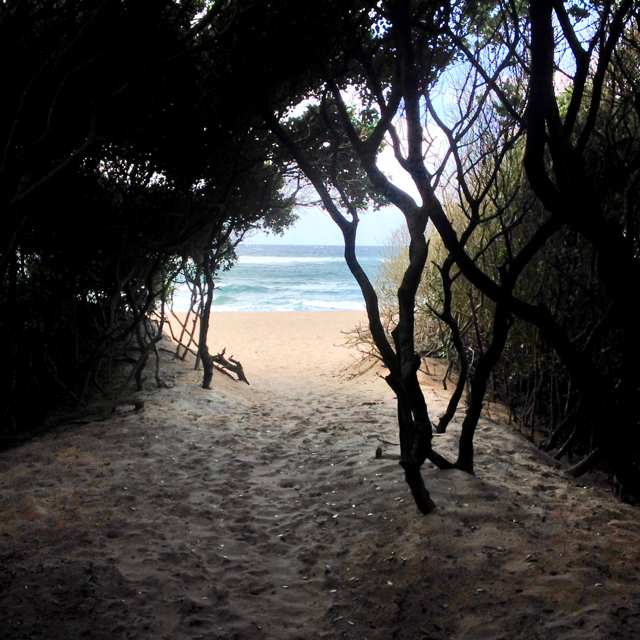
At the top of a small dune we see a long white beach curving in each direction and the bright blue ocean in front of us. We take a walk further along the track and along the shore past some beach cottages then return along the sand paddling as we go. This is definitely the spot for a picnic lunch. After lunch Paul ventures in for a swim but the surf looks a little strong for me and then we settle back in our chairs to enjoy the afternoon. Smiley finds us there and tells us he has arranged for us to join a turtle watching tour this evening and we should meet the guide at 6.00 pm so we decide to stay where we are and have a snack before the tour and return to the camp to set up and eat dinner afterward.
We arrive at the meeting spot on time and are soon joined by a couple of other small groups. Eventually there are about ten in our group and the guide explains what we would be doing and what we should expect. We walk up the beach spotting a couple of tracks where turtles had climbed up to the dunes but then returned to the ocean without laying their eggs.

The rain yesterday compacted the sand so it is too hard for the turtle to dig a sufficiently deep pit at that spot, she will try again tomorrow night. Further along sharp eyes spot a turtle emerging from the sea ahead of us. We are waved back and settle down on the sand to wait as we are not allowed to interfere or approach the turtle while she is on her way up the beach. If she begins laying we can then approach and watch. Its about a twenty to thirty minute wait but it certainly is no hardship as the evening is balmy and we have a full moon above us to watch the waves breaking on to the shore below us and a few stars twinkling in the sky. Scudding clouds throw shadows and shift the scene from dark to bright.
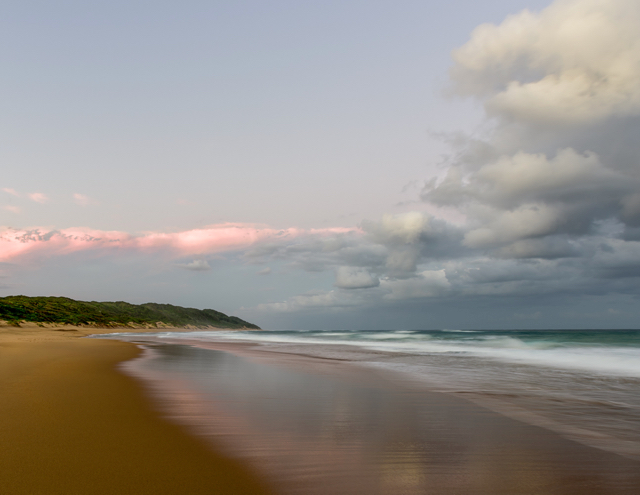
Our wait is largely in vain as the sand is too firm and she is returning to the ocean. We are allowed to approach her now to watch her crawl back to the sea and as the waves reach her she effortlessly glides off into the ocean. A short way along the beach another turtle is returning to the ocean after another unsuccessful attempt, her efforts thwarted this time by driftwood blocking her access into the dune. A more successful effort is in progress further along the beach and the egg laying is being monitored by four university students. Our guide speaks to them and if we are unsuccessful in finding a turtle laying soon we will be able to return here.
Another turtle is spotted but yet again the damp sand has interfered with the egg laying. We’ve walked quite a long distance through soft sand by now so we are happy to return to the previous location. Its great to watch the turtle laying and an added bonus to observe the students. They are all studying different aspects of turtle life and one explains the various observations being made including measurement of a sample of the eggs, scraping of parasites and treatment of the wound, scraping cells from the shell to determine where the turtle has been and setting of camera traps to identify predators which interfere with nests and hatchlings. By the time we return to our starting point it is after 10.00 pm and we are very leg weary from trudging through the soft sand. Back at camp we quickly set up our roof top tent and have a quick snack before collapsing into bed.
This is a wonderful place and we would be happy to stay longer, particularly if we could camp at the back of the beach or stay in one of the beach cottages but we have plenty more places to see in limited time. We had thought to drive down a sandy 4WD track through coastal forest to Sodwana with an overnight stay at a camp along the way but we’ve been checking the map and realise we have missed two game parks in the vicinity. Tembe Elephant Park has a wide range of wildlife including the big 5 but there is no camping there and the accommodation is in an expensive private lodge. Ndumo Game Reserve is just a short distance further and as well as having camping and reasonably priced huts it is renowned for its wetlands and bird life.
We reach Ndumo by the middle of the day and the weather has turned hot again. There is one other couple in the campground and lots of shady trees so it is easy to find a good spot. Lunch and a dip in the pool fills in the early afternoon and mid afternoon we set out to explore planning to finish our drive with sunset at a hide overlooking one of the pans. The bush is thick which is good cover for the animals but we spot nyala, kudu, impala and bushbuck. Birds are plentiful but once again difficult to spot but we manage to identify a few different species. We visit a viewing tower set on a rise and from the platform we can see across the park. By now it is time to drive to the hide. It is a reasonable walk from the carpark but it is good to stretch the legs after yesterdays exertions, the soft sand has left a few muscles aching. The hide is well made and well situated. That is it would be well situated if there were water in the pan in front of us but the drought of the past years has left the hide several hundred metres from the nearest water. The levels here won’t rise until the dam near Jozini fills and they allow the water to run through again and that could be a long time coming. We can see bird life through our binoculars but they are too far away to observe properly or to photograph.
Ndumo is a very friendly and pleasant little park and would be well worth a visit when the pans are at their normal levels but although we had planned to spend at least part of the next day here we make an early start so we have time to visit Tembe on our way back to the coast. Access at this park is limited to 4WD vehicles as the tracks are quite sandy. We get a map and a suggested itinerary we should be able to complete in the time we have available. Our first stop is at Mahlasela Hide which is where we are most likely to see elephant. Once again the bush is thick and we spot various types of buck as we go. The view from the hide doesn’t disappoint, a pool of water is directly in front of the hide and it is a focus for animals in this area. Two elephants, a large group of waterbuck, several impala and a variety of large water birds are scattered around the waterhole and at the entrance to the hide a flock of weaver birds are building their nests. It is certainly worth stopping here for a while so I fill the coffee plunger and return to the hide so we can combine the stop with our morning cuppa. Two waterbuck fight to determine dominance but it seems obvious they are not ready to settle the matter just yet.
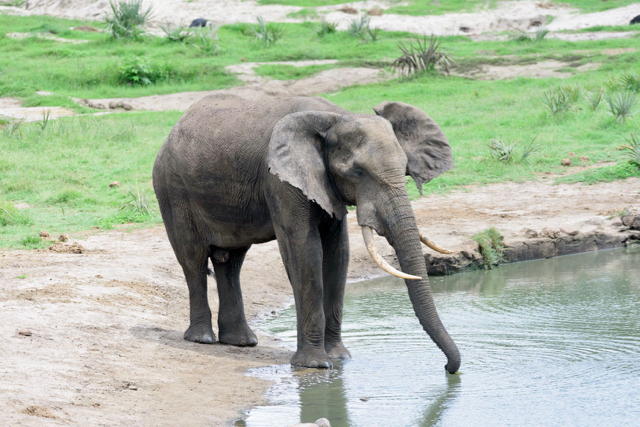
We finally decide that if we want to see any more of the park we need to leave here and continue through the park to the next hide. The scenery along the way changes several times. We drive through bush, then alongside sand dunes and later skirt a large swamp before arriving at the hide. This has less to offer but the drive here was certainly worthwhile. We continue to a picnic spot for lunch and by now we have to start to think about heading back to the park entrance as we have a long drive still today so we skip the rest of the suggested itinerary and leave very content with our visit.
We retrace our route along the highways to the turnoff for Sodwana which is in central area of the iSismangaliso Wetland Park. Its an easy drive but it is still after 5.00pm when we arrive at the national park camping area. The office is closed but the security guard directs us to one of the camping areas and as the holiday season has finished we have no difficulties finding a pleasant site. There are hundreds of camp sites spread between eight camping areas here and in the peak period the whole lot are full. That is way too many people for us which is why we waited to come here until after the school holidays had finished. One of the reasons we are here is because it is one of the major spots for scuba diving in South Africa with several reefs and numerous dive sites in easy reach. Coral Divers are one of the larger dive companies here and they have been recommended to us and are situated inside the national park so after breakfast we call there to see about a dive or two for me tomorrow. They recommend getting a campsite near their dive operations and lodge which we easily arrange. Our new campsite is surrounded by bush and there are no other campers nearby. Two small red duikers bound away when they see us but we often see them and others nearby while we are here. Its drizzling rain by now so we delay setting up camp again and drive to the small collection of lodges and shops just outside the park entrance. There isn’t a lot open in this quiet period and on such a grey day but we manage to find a place with nice coffee and I sample their ‘chilli poppers’, small pastries filled with cheese and jalapeños, very tasty and warming.
I’m booked into two dives next day so I’m up early and I’m in my wetsuit and ready to go soon after 6.00am. We climb into the shuttle along with the rest of our gear for the ten minute trip to the beach where the boats launch. It is my first dive for two and a half years so I’m a little anxious and concerned I would forget some of the basic steps of getting the gear organised. I should have realised I needn’t worry about that as there are always people willing to help out and my gear is assembled and checked and carried to the boat for me. A tractor helps push the boat out into the waves and we clamber on board, certainly not an elegant move when I do it but the young ones are much more agile. There are three other divers and the dive master in my group and there are a couple of other small groups with students completing their certification so we have a full boat load. Life jackets are distributed and have to be securely fastened, we sit on the sides with our feet under straps on the floor and we have to hold on to ropes before we take off. I wonder a little at the precautions but soon understand. The ride out through the breaking waves is fast and fun with a lot of bouncing as we crest the waves. The boat driver is well practised and after travelling along the side of a wave he finds a break and we are through the rough section.
Its an easy ride from there to the reef and at the signal we all tumble into the water, find our buddies and descend to the reef below. I take a little while to clear my ears and to descend but once down it is all pure enjoyment. Its a nice slow dive with time to take in all the corals, fish and other creatures. A large ray shelters under a rock overhang and a turtle swims lazily past before stopping to snack. We aren’t particularly deep so colours are good and the current is very mild so photographers have plenty of time to get their shots. As usual the time passes very quickly and soon our 50 minutes is up and we return to the boat for another inelegant boarding.
After another fast trip through the surf to the beach we have an hour to wait before the next dive. Time passes very easily chatting to other divers then we repeat the operation. I’m glad I booked a second dive as although I thoroughly enjoyed my first dive I realise I am much more relaxed for my second dive. The descent is much easier and I am able to control my buoyancy with ease. We are diving on the same reef but on a different site and there seems to be more fish around this dive and they entertain and delight. The strangest fish we see is a stone fish walking along the bottom and I also love spotting the tiny nudibranchs and the brightly coloured christmas tree anemones. Its has been a great morning, I’m not sure when my next dive will be as although there is diving on the south and west coasts of South Africa the water is much colder.
In my absence Paul has packed up camp and is waiting for me at the Coral Divers Resort. There is time for lunch and a shower after I return then we resume our journey south. Once again it is an easy trip back to the highway then on the freeway until we reach the turn to St Lucia. St Lucia is a pretty village surrounded by the southern section of the iSimangaliso Wetland Park. Once again we arrive after the office has closed and the camping area we had planned to stay in appears to be closed for the season but the other camp ground is open and has plenty of space so we set up for the night.
The beaches here are not quite what we are after so in the morning we drive north through the national park to Cape Vidal. Its only a 35 km drive but as it is in the national park there is a 40kph speed limit and there are several loop roads to explore along the way. We have no sooner passed through the gates and over the grid into the park when we see a warthog family and zebra and while we are watching them Paul spots a jackal, a good start. The country is mainly open grassland but we also pass through sections of thick bush and see some large dunes and the bottom of the huge Lake St Lucia. We spot other game as we travel including a male kudu with an enormous and beautiful pair of horns who strolls along the side of the road right past us. We’re looking forward to the views at Mission Rocks but the road in is closed for maintenance so we settle for a walk to the nearby lookout which gives us a good view over the ocean and the lake as well as the forests and grassland in between.
Cape Vidal is delightful with a pretty beach and some interesting rocks and a small campground set behind a dune which provides good shelter. There are more sites occupied here than at some of the larger camping areas we have been at and there are still some large groups occupying several sites each but there are enough vacant spots for us to find one we are very happy with and we are all set up before lunch. The afternoon is easily spent with a swim and a walk along the beach and Paul picks his spots for his sunrise photos next morning before we return to the camp for the evening.
The next day it is time for us to return to Durban and we take the easy route straight down the freeway arriving back at Sarah’s mid afternoon. Paul has some work to do on photos and we have a few other chores to attend to so we spend the next three days enjoying the company and comforts there before we are ready to continue our journey.
We have time to see a little more of KZN before we leave the province and we set off with trailer in tow. We visited the northern section of the Drakensberg mountains on our way to Durban and this time we are headed toward the central section. There are several interesting spots to choose between and we settle on the Monks Cowl camping area in the Champagne Valley. Much of the way we are either travelling along freeways or retracing the route we followed on our way into Durban but it is still pleasant and easy. Once we leave our previous path we are heading directly toward the mountains and the closer we get the more dramatic is the scenery. The final section is steep and winding and we crawl up some of the hills in first gear which gives us plenty of time to admire the view as we go.
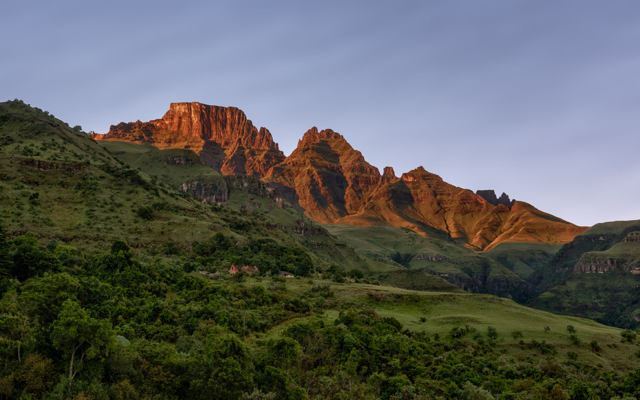
The national park campground is not large but while there are a few other campers we have plenty of spots to choose between. Many of the sites are not level and recent rain has made some of them boggy but the backdrop of the mountains and hills all around us more than compensates and we are soon setting up the trailer for the first time since we left Johannesburg. We weren’t happy with the way we organised the food and cooking items in the land cruiser on the trip we have just completed so we want to reorganise as we will soon be heading off again without the trailer. We have also just bought a huge new silver tarp to help keep the trailer tent cool so we want to try that out and work out the best way to use it so much of the next day is spent on those chores plus on Paul finishing some photography work and of course taking more photographs. We take a drive in the afternoon to enjoy the scenery in the valley and call into a few places on our way. The best of these is the Valley Bakery where we buy some croissants (and a jam doughnut) and plan to return in the morning for fresh bread.
After we leave KZN we will be visiting Lesotho for a week or so and we will leave the trailer in the Underberg area so we use Google maps to find the best way to travel between Champagne Valley and Underberg. It offers us three options, the shortest is the longest and the longest is the shortest and naturally we choose the longest, shortest route. That’s the one which will take the most time but is the least distance as it cuts across the foothills at the base of the mountains rather than heading out to the freeway, travelling south then back along the main road to Underberg.
The road surface varies from bitumen to good gravel roads to rocky and rutted roads but the views remain brilliant all along the way. We’ve left behind the towns and we travel through villages with thatch roofed round houses and waving children and all the time the Drakensberg mountains rise high on our right hand side. The road travels up and down the hills quite often so our pace is slow. They are only the foothills but for much of the day we are at altitudes higher than Australian mountains. The morning started out sunny but clouds have been building and in the early afternoon the rain starts and continues for the most of the rest of the day. The roads become muddy and by the time we are making our final descent out of the foothills and toward Underberg they are becoming slippery. Our 4WD handles the conditions well but there are plenty of mini buses and small cars sliding around and their drivers are obviously used to confronting these conditions.
With the rain and drizzle continuing we are rethinking our plan to sleep in the roof top tent overnight and looking for reasonably priced alternatives where we can leave the trailer for the next week. This is a popular tourist destination so there are lots of B&B’s in the area and after making enquiries we are directed to one in the nearby village of Himeville. This is a very pretty village which has a decided atmosphere of old England. We like the room offered at the B&B and we can leave our trailer parked securely and connected to power so its an easy decision. There are facilities for cooking available but its been a long day and a counter meal at the local pub sounds very appealing, another easy decision. The meal is all we hoped for, basic but tasty, and the atmosphere is great, a real village watering hole with lots of locals and a (not very good) band playing in the next room. Time for a good nights rest before our next adventure and the next country.
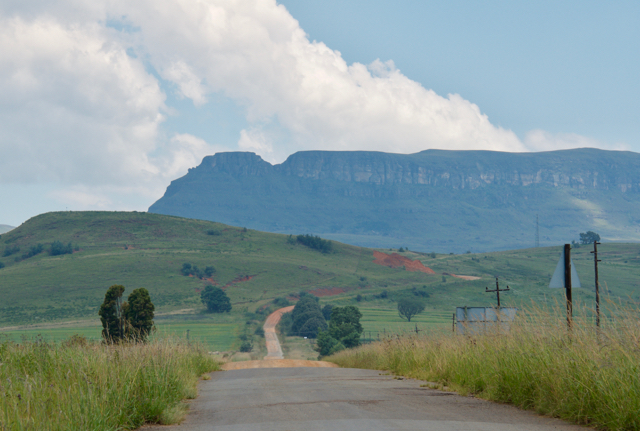


















Sounds like an amazingly picturesque landscape. Happy you could get those two dives in Julie. Didn’t realise it had been so long since your last ones. Time flies when you’re having fun. Keep it up.
LikeLiked by 1 person